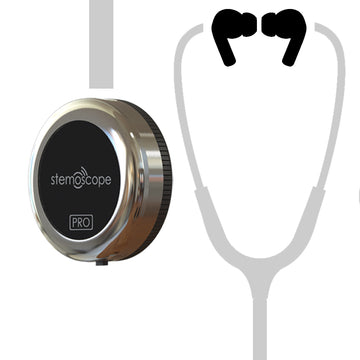The History and Evolution of Precordial Stethoscopes: Embracing Technology with Bluetooth Connectivity

The precordial stethoscope, a vital tool in the realm of medical monitoring, has undergone a significant transformation since its inception. Initially designed for auscultation of heart sounds, its evolution has been marked by technological advancements, notably the integration of Bluetooth technology. This blog post delves into the historical journey of the precordial stethoscope, highlighting its evolution and the impact of Bluetooth connectivity, especially in the field of anesthesia.
The Origins of the Precordial Stethoscope
The concept of the precordial stethoscope dates back to the early 20th century when it was first used to monitor heart sounds during surgical procedures. Its primary function was to provide an auditory link between the patient's heart and the anesthesiologist, ensuring the continuous monitoring of cardiac activity. The term precordial refers to its placement on the chest (precordium), directly over the heart, to capture the most accurate heart sounds.
Evolution Through the Decades
Over the decades, the design and functionality of the precordial stethoscope have seen significant improvements. From the basic acoustic models to more sophisticated electronic versions, each iteration has aimed to enhance the clarity and reliability of heart sound monitoring. The advent of electronic stethoscopes in the late 20th century marked a pivotal shift, offering amplified sound and noise reduction capabilities.
The Advent of Bluetooth Technology
The most groundbreaking advancement in the evolution of the precordial stethoscope has been the integration of Bluetooth technology. This innovation has led to the development of the Bluetooth precordial stethoscope, a wireless device that offers unprecedented convenience and mobility for medical professionals, particularly in the field of anesthesia.
Precordial Stethoscope Bluetooth: A Game-Changer in Anesthesia Monitoring
The Bluetooth precordial stethoscope has revolutionized the way anesthesiologists monitor patients during surgeries. By eliminating the need for physical cables, it provides greater freedom of movement and reduces the risk of contamination. The wireless connectivity ensures that heart sounds can be transmitted in real-time to a Bluetooth-enabled device, such as a tablet or smartphone, allowing for continuous monitoring without being tethered to the patient.
Enhanced Patient Care and Safety
The incorporation of Bluetooth technology in precordial stethoscopes has significantly enhanced patient care and safety in anesthesia. It allows for more accurate and efficient monitoring of cardiac activity, enabling anesthesiologists to detect any abnormalities or changes in heart function promptly. This early detection is crucial in preventing complications and ensuring the well-being of the patient.
The Future of Precordial Stethoscopes
As technology continues to advance, the future of precordial stethoscopes looks promising. We can anticipate further enhancements in sound quality, connectivity, and integration with other medical devices. The potential for artificial intelligence and machine learning to provide predictive analytics based on heart sounds could offer even greater insights into patient health.
The history and evolution of the precordial stethoscope illustrate the remarkable journey of a medical device that has adapted and embraced technological advancements. The integration of Bluetooth technology has transformed it into an indispensable tool in anesthesia monitoring, providing enhanced mobility, convenience, and patient safety. As we look forward to future innovations, the precordial stethoscope will undoubtedly continue to play a pivotal role in the advancement of medical monitoring.
We'd Love to Hear From You!
Do you have any thoughts or experiences related to what we discussed today? Maybe a tip to share or a question to ask? Please feel free to leave a comment below. Your insights not only help us to improve our content but also create a vibrant community where we can all learn from each other. Don't be shy—drop us a line below!











